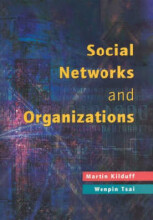Summary: Social Networks And Organizations | 9780761969570 | Martin Kilduff, et al
- This + 400k other summaries
- A unique study and practice tool
- Never study anything twice again
- Get the grades you hope for
- 100% sure, 100% understanding
Read the summary and the most important questions on Social networks and organizations | 9780761969570 | Martin Kilduff; Wenpin Tsai.
-
1 Introduction
-
Paul Revere and William Dawes rode different routes from outside Boston to Lexington warning communities along the way of the imminent threat from the British army. Why was there a difference in the reception of this identical message?
Paul Revere was connected to an extensive network of strategic relationships whereas William Dawes' connections were less useful. Revere knew exactly who's door to knock on, who the local militia leader was, who the key players in town were. And these leaders themselves sent riders to alert the surrounding areas.
-
2 Understanding Social Network Research
This is a preview. There are 10 more flashcards available for chapter 2
Show more cards here -
2.2 Distinctive features of the social network approach
-
What are measures of centrality?
1. Degree
2. Betweenness
3. Closeness
4. Eigenvector
-
What is degree centrality? What do indegree and outdegree measure?
The total number of incoming (indegree) and outgoing (outdegree) relations.
Indegree: is a measure of status or popularity
Outdegree: is a measure of activity (example: how often do you interact with people, go to people for advice)
-
What is betweenness centrality?
How often an actor lies along the shortest path between two other actors, connecting otherwise disconnected others.
-
What is closeness centrality? And what is an advantage of being high in closeness centrality?
The total number of steps needed to reach everyone (=the reciprocal of the distances to all others). It measures the expected time until arrival.
It minimizes one's dependence on intermediaries
-
What is eigenvector centrality? Is a measure of what?
Being connected to actors who are themselves connected. Being tied to people with many ties. Is a measure of exposure, status and popularity.
-
What are distinctive features of network research from traditional approaches?
1. It focuses on relations and the patterns of relations rather than on attributes of actors
2. It is amenable to multiple levels of analysis and can thus provide micro-macro linkages
3. It can integrate quantitative, qualitative and graphical data, allowing more thorough and in-depth analysis.
-
2.3 Relations and patterns of relations
This is a preview. There are 1 more flashcards available for chapter 2.3
Show more cards here -
Why a network approach?
It can test whether the pattern of network ties in a particular social world is related to other important patterns such as the pattern of decision-making
-
What does the assymetric data mean in the matrix?
It shows that a tie is a one-way relationship: A considers B to be a friend but B does not consider A as a friend.
-
What are social structures?
Patterns of connectivity and cleavage within social systems.
Abstract representations of patterns of relationships between actors.
- Higher grades + faster learning
- Never study anything twice
- 100% sure, 100% understanding
































